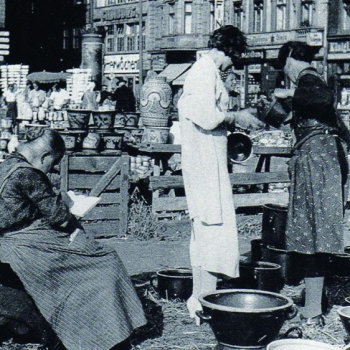

HomeNews & BlogHistory of Bolesławiec pottery

Read all about a historic town founded in the 13th century and located in the Lower Silesian Voivodeship in Poland. Best-known for the long-established tradition of pottery-making, Boleslawiec with its long ceramic history has become one of the go-to places to visit on a pottery treasure hunt. Often described as “Polish stoneware”, the Boleslawiec pottery to this day is considered as one of the unofficial cultural symbols of Poland.
The ceramics’ characteristic style evolved from a folk tradition into a distinct ceramic category distinguishable by form, decoration, glaze and fabric. It’s not a coincidence that over time the town has turned into one of the Europe’s best-known handmade pottery spots. The area is rich in clays used in the potter’s wheel. According to the archaeological evidence, the first signs of pottery date back to the 7th century; however, it wasn’t until the 14th century when the evidence demonstrating potting activities was actually documented. Contrary to the popular belief, the first ceramics were characterized by the brown lead glaze and not the blue-on-white patterns.
Even though the Bolesławiec’s history is rather complicated, as this part of Poland was under the control of many different nations, the pottery tradition has remained unchanged. It was also seen as the national treasure of any kingdom which ruled over the Silesian territory during that time. The ceramic industry has been especially promoted under the auspices of the Prussian kings, when it was widely known as “Bunzlauer” pottery. During this period the Prussian government intervened in favour of increased pottery production. The hand-made products earned wide recognition throughout the German states, which later spread into Russia and Austria. However, it wasn’t until the lead glaze was announced as dangerous to health that the Boleslawiec ceramics gained sudden popularity.
Interestingly, one of the most revolutionary phases took place in the 18th century, when a new wave of German potters arrived with a new type of pot. During this time the European elite was enjoying the new drink of choice – coffee. Along with the fashionable beverage came the new tableware – modern coffee pots along with sugar bowls, milk pitchers, as well as jam jars, and many more container types.
The art we know today was developed throughout the 19th century and has continued ever since. Boleslawiec is often called the “Town of ceramics”. Besides your typical kitchenware, what has survived is the “fancy ware”. Fancy ware is intended for display on the table or somewhere in the living room and used with caution and proper care. In that time many family-run pottery shops opened, which resulted in a near doubling of the number of ceramic manufacturers.
The growing competition, lifestyle changes and increasing urbanization, as well as rising interest in metalware and glass production led to sales reductions. By the end of the 19th century, many firms went out of business and were forced to close. The remaining potters had to adjust to new realities and the demand of the middle-class consumers, who were looking for smaller pottery intended mainly for display. In order to catch the potential customers’ attention, craftsmen had to experiment with new styles and techniques.
The iconic blue decorative pattern hand-painted on a white background makes stoneware pieces very unique and therefore easily identifiable. They have become pretty popular among Europeans, but there are also ceramic-enthusiasts from various parts of the world. The blue-on-white spongeware and swirlware had started to peak by the end of the 19th century. It was the time when the Boleslawiec ceramics experienced a major transformation – from the clear feldspathic glazes to the colourful, iconic pattern we know today.
The ceramics were beautifully decorated with all kinds of ornamental patterns. Of course, the most distinctive ones are polka dots, but with the rise of new techniques, other motifs received the same attention. Thanks to the use of cut sponges and brushes, the ware was decorated with imaginative organic motifs derived from the Jugendstil aesthetic.
Jugendstil, also known as “Young Style” or “Art Nouveau” is a German artistic movement popular at the turn of the 19th and 20th century. It was often inspired by natural forms such as sinuous curves of flowers and plants. One of the most distinctive patterns is the so-called Pfauenauge - peacock’s eye, which became one of the signature trademarks of German spongeware. It was also when the first professional ceramics school was founded in Bolesławiec (1897).
Throughout history, the ware was decorated with many different motifs. Starting with the Bolesławiec emblem and the emblem of potters (Adam and Eve), ending with heraldic signs and other themes, including fauna and flora. With the rise of the lead-free glaze, new techniques pioneered which enabled stamping, and therefore an ascent of new motifs and designs. Some of those remained popular to this day. These include circles, scales, flowers, dots and clovers, which gave the ceramics a more “country” appearance. It was also when individual potters and workshops began to mark their pots and some of the smaller, family-run businesses expanded into large-scale ceramic factories.
Even with the influx of new trends and modern technologies, Boleslawiec pottery has remained the same. What has changed, however, is the durability and functionalities of the dishes. To be more precise, modern traditional handmade pottery from Poland is dishwasher- and microwave-safe, and can be used for food storage in refrigerators. It is beloved by many and has even gained a following among private collectors across the world. The ware is sold for both, everyday use in the kitchen, as well as collectibles.
Photo source: https://ceramicboleslawiec.com.pl/about-us/?lang=en
30
JUN
2021
821
TIMES
READ
traditionalpottery.co.uk
traditionalpottery.co.uk